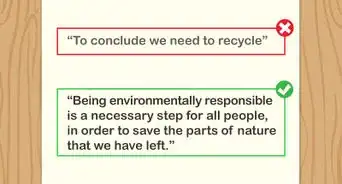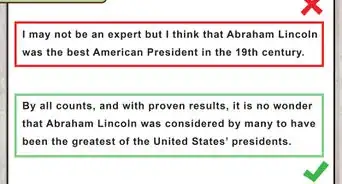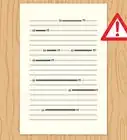This article was co-authored by Christopher Taylor, PhD. Christopher Taylor is an Adjunct Assistant Professor of English at Austin Community College in Texas. He received his PhD in English Literature and Medieval Studies from the University of Texas at Austin in 2014.
There are 8 references cited in this article, which can be found at the bottom of the page.
This article has been viewed 20,100 times.
Analogies are an important part of writing and test-taking in many schools, but they can be a challenge to master. When writing, analogies make comparisons between two concepts so that your reader can better understand something unfamiliar. On tests, questions called verbal analogies test your reasoning by asking you to properly complete comparisons. It might take some practice to understand analogies, but when you learn the concept and work on it a little every day, you can master them.
Steps
Solving Verbal Analogies on Tests
-
1Learn the analogy symbols. Before you can start solving verbal analogies on a test, you have to learn to read them. The symbol “ : ” means “is to” while the “ :: ” symbol means “as.” So an analogy that reads “doctor : hospital : : basketball player : arena” actually means, “doctor is to hospital as basketball player is to arena.”[1]
-
2Master the common types of analogical relationships. Analogies can come in almost any form, but on tests they often follow certain types of relationships. Analogies are often on simple relationships like synonyms, antonyms, parts to a whole, or actions to a result. They may also include:[2]
- Uses, such as cup is to drink.
- Users, such as contractor is to hammer.
- Places, such as Santiago is to Chile.
- Product to producer, such as wool is to sheep.
- Degree of intensity, such as warm is to scalding.
Advertisement -
3Establish the type of relationship. Reading an analogy is just the beginning. The analogy setup tells you that the relationship between the two parts of the analogy is the same. To properly complete an analogy, you need to determine the nature of the relationship provided by the test question.
- If you have an analogy saying, “water : glass : : cereal : _____,” then you need to think about how the water and glass relate to each other. Water goes in a glass, so the proper choice for the cereal would be “bowl” as opposed to choices like “plate” or “spoon.”
-
4Take your time. Analogies may come up on timed tests, which can make them extra stressful. Good time management is required for any test, but it can actually hurt you to rush through a section. Instead of rushing through as fast as you can, allot a designated amount of time to answer each question. If you can’t answer it in your time frame, then move on.[3]
- If you have 30 minutes to complete 50 analogies, for example, you could allow 30 seconds for each question. This gives you time to consider each question, as well as a buffer to go back and answer questions you skipped earlier.
Using Analogies in Your Writing
-
1Learn to distinguish metaphors, similes, and analogies. These three rhetorical devices are similar, but they aren’t exactly the same. A metaphor makes a direct comparison to establish a new meaning. A simile makes a simple comparison using “like” or “as.” An analogy also compares, but typically makes a more complex argument by focusing on relationships.[4]
- “Her smile was a ray of sunshine,” would be a metaphor. “Her smile was as bright as a beam of sun,” would be a simile. An analogy would make more particular comparisons between a smile and the sun. “The warmth and intensity of her smile was as bright as a beam of light,” makes multiple, direct connections between the smile and light.
- “That meeting was a rollercoaster,” is a metaphor. “That meeting was like a rollercoaster,” is a simile. “That meeting was a rollercoaster ride of emotions,” is an example of an analogy.
-
2Determine if your comparison needs an analogy. Not every type of comparison needs an analogy. Metaphors and similes work better for simple comparisons. Think about what you want to compare. Analogies work best for concepts rather than individual subjects such as a person or object.[5]
- Comparing the color of a blue shirt to the color of the sky, for example, would best be done with a simile or metaphor. Comparing the movement of electricity through wires to the flow of water through pipes, however, should be done with an analogy.
-
3Make a direct connection. Analogies do not need to be long or fancy. Their purpose is to make a concept easier to understand. Start your analogy by making a direct comparison between your two subjects. Then, you can point out how your subjects are similar.
- When describing an okapi, for example, it is easiest to say, "This animal looks like a short-necked giraffe with zebra striping on its legs and brown fur on its body." This draws on what your reader already knows about zebras and giraffes to help them visualize the animal.
-
4Avoid over-comparing. Your analogy should do most of the comparing for you. Gently point out how your concepts are similar. Resist the urge to make a detailed comparison. After all, the whole point of your analogy is to avoid going into complex detail.
- With the water and electricity example, the comparison would be that electricity flows through wires like water through pipes. You do not need to explain how electric currents are generated to get your point across.[6]
Working on Analogies at Home
-
1Take a practice test for verbal analogies. If you are working on verbal analogies, take a few practice tests before you take your real test. These will help you get a better idea of the types of analogies that will be on your test. It will also help you practice good time management.[7]
- Make sure to take a practice test similar to the test you will take. An ACT prep test won’t help you much if you are getting ready for the GRE.
- There are a number of practice tests available for free online for a broad range of tests. Take a few tests from a few sources to get more practice.
-
2Write your own prompts. Help build your analogy writing skills by creating a list of prompts. Then, take two to three minutes each day to respond to one of your prompts. Some potential analogical prompts could include:
- What if feels like getting out of bed.
- How you feel taking a difficult test.
- What it’s like to finish a good book.
- How you go about trying to make new friends.
- How to make a peanut butter and jelly sandwich.
-
3Try your analogies on a friend. Once you have developed a few good analogies, read them out to a friend and ask for feedback. Have them tell you if your analogies make sense. If they don’t, ask them what is unclear and use their feedback to revise them.[8]
References
- ↑ http://www.mhhe.com/socscience/english/spears/stu3/studisk/verbal_analogies/va_intro.htm
- ↑ http://www.vocabulary.co.il/analogy_relationships/
- ↑ https://www.kaptest.com/blog/med-school-pulse/2016/07/06/mastering-test-day-time-management/
- ↑ http://www.copyblogger.com/metaphor-simile-and-analogy-whats-the-difference/
- ↑ http://examples.yourdictionary.com/analogy-ex.html
- ↑ https://www.teachervision.com/professional-development/metaphors-analogies
- ↑ https://www.kaptest.com/blog/grad-school-insider/2017/06/21/manne-plan-take-free-gre-practice-test/
- ↑ https://goinswriter.com/get-a-peer-editor/

































































